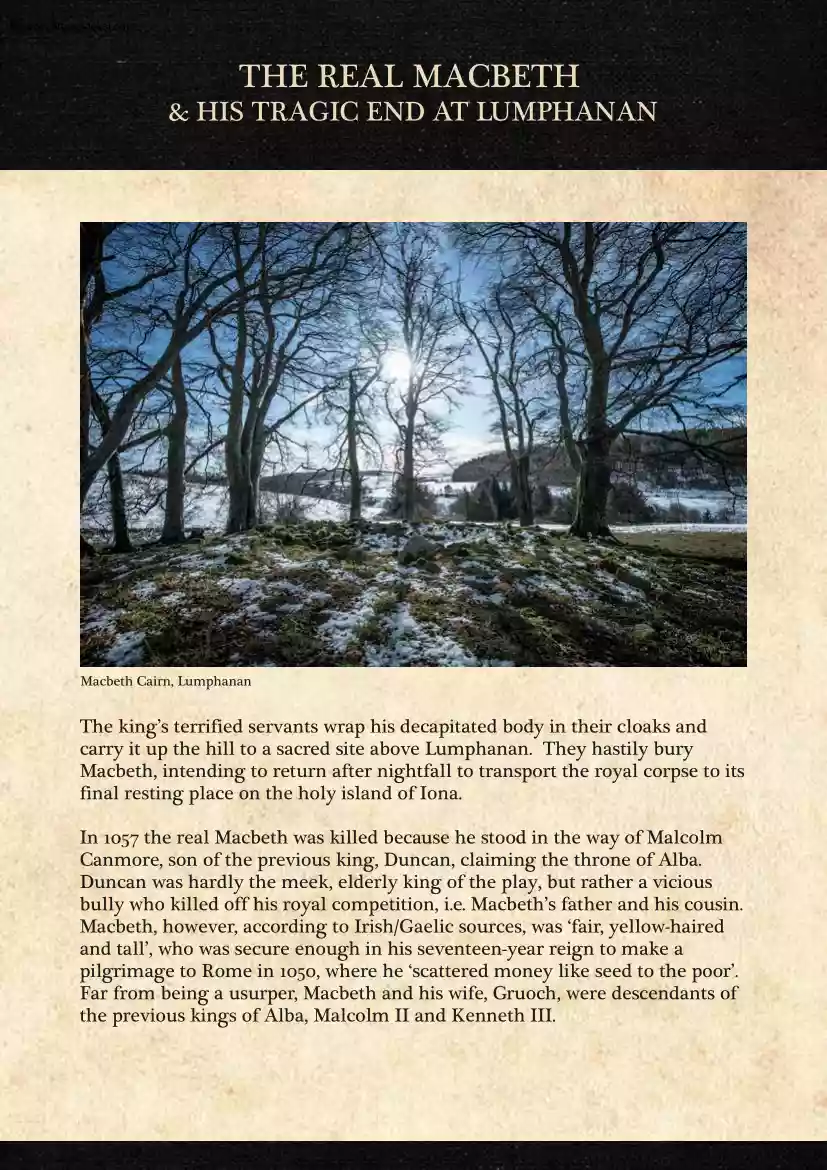Alapadatok
Év, oldalszám:2021, 2 oldal
Nyelv:angol
Letöltések száma:3
Feltöltve:2021. június 21.
Méret:988 KB
Intézmény:
-
Megjegyzés:
Csatolmány:-
Letöltés PDF-ben:Kérlek jelentkezz be!
Értékelések
Nincs még értékelés. Legyél Te az első!Legnépszerűbb doksik ebben a kategóriában
Tartalmi kivonat
THE REAL MACBETH & HIS TRAGIC END AT LUMPHANAN Macbeth Cairn, Lumphanan The king’s terrified servants wrap his decapitated body in their cloaks and carry it up the hill to a sacred site above Lumphanan. They hastily bury Macbeth, intending to return after nightfall to transport the royal corpse to its final resting place on the holy island of Iona. In 1057 the real Macbeth was killed because he stood in the way of Malcolm Canmore, son of the previous king, Duncan, claiming the throne of Alba. Duncan was hardly the meek, elderly king of the play, but rather a vicious bully who killed off his royal competition, i.e Macbeth’s father and his cousin Macbeth, however, according to Irish/Gaelic sources, was ‘fair, yellow-haired and tall’, who was secure enough in his seventeen-year reign to make a pilgrimage to Rome in 1050, where he ‘scattered money like seed to the poor’. Far from being a usurper, Macbeth and his wife, Gruoch, were descendants of the previous kings of
Alba, Malcolm II and Kenneth III. THE REAL MACBETH & HIS TRAGIC END AT LUMPHANAN The ‘Scottish Play’ with which we are all familiar, is in fact a total reversal of the truth, written to please James VI who had recently become James I of a new United Kingdom. Shakespeare appealed to James’ obsession with witchcraft and the supernatural, weaving a romantic origin for the Stuarts in Banquo whom the witches prophesy ‘Thou wilt get kings, though thou be none.’ The play proved one of the most popular of Shakespeare’s ‘histories’ despite it being mostly pro-Stuart fiction. So why did the Bard get it so wrong? His main historical source, Raphael Holinshed, was relying on misleading accounts of Macbeth written over centuries as Celtic Alba evolved into Anglo-Norman Scotland. The real tragedy is that these accounts were written by Scottish chroniclers from a time when the Stuart dynasty was in the ascendancy. Three centuries after Macbeth’s reign, John of Fordun’s
Scotichronicon describes Duncan’s death in battle as murder and invents the character of Macduff as a former friend of Macbeth. Andrew of Wyntoun, writing forty years later, weaves a vile fairytale, introducing the witches, Macduff’s charm as ‘the knight who was never born’ and describes Macbeth as a ‘son of the Devil.’ Hector Boece, principal of Kings College, Aberdeen, writing in the 1500s, further adds the characters of Banquo, Lady Macbeth and states that Macbeth kills Macduff’s family. Thus, the lie was complete! Macbeth’s reign ended in a bloody skirmish outside Lumphanan, when Malcolm slew him in hand-to-hand combat and cut off his head as a trophy. The queen placed her son, Lulach on the throne, only for him also to be murdered by Malcolm Canmore, who finally secured the kingdom in 1058. The ‘cairn’ which served as Macbeth’s temporary tomb was excavated in 1855 and is likely to have been a prehistoric cist burial. No bones remain today The cairn is on
private land, but a quick polite enquiry to the farmhouse below Perkhill usually ensures visitors can cross the fields to pay their respects
Alba, Malcolm II and Kenneth III. THE REAL MACBETH & HIS TRAGIC END AT LUMPHANAN The ‘Scottish Play’ with which we are all familiar, is in fact a total reversal of the truth, written to please James VI who had recently become James I of a new United Kingdom. Shakespeare appealed to James’ obsession with witchcraft and the supernatural, weaving a romantic origin for the Stuarts in Banquo whom the witches prophesy ‘Thou wilt get kings, though thou be none.’ The play proved one of the most popular of Shakespeare’s ‘histories’ despite it being mostly pro-Stuart fiction. So why did the Bard get it so wrong? His main historical source, Raphael Holinshed, was relying on misleading accounts of Macbeth written over centuries as Celtic Alba evolved into Anglo-Norman Scotland. The real tragedy is that these accounts were written by Scottish chroniclers from a time when the Stuart dynasty was in the ascendancy. Three centuries after Macbeth’s reign, John of Fordun’s
Scotichronicon describes Duncan’s death in battle as murder and invents the character of Macduff as a former friend of Macbeth. Andrew of Wyntoun, writing forty years later, weaves a vile fairytale, introducing the witches, Macduff’s charm as ‘the knight who was never born’ and describes Macbeth as a ‘son of the Devil.’ Hector Boece, principal of Kings College, Aberdeen, writing in the 1500s, further adds the characters of Banquo, Lady Macbeth and states that Macbeth kills Macduff’s family. Thus, the lie was complete! Macbeth’s reign ended in a bloody skirmish outside Lumphanan, when Malcolm slew him in hand-to-hand combat and cut off his head as a trophy. The queen placed her son, Lulach on the throne, only for him also to be murdered by Malcolm Canmore, who finally secured the kingdom in 1058. The ‘cairn’ which served as Macbeth’s temporary tomb was excavated in 1855 and is likely to have been a prehistoric cist burial. No bones remain today The cairn is on
private land, but a quick polite enquiry to the farmhouse below Perkhill usually ensures visitors can cross the fields to pay their respects





 1917. május 29-én, a Massachusetts állambeli Brookline-ban egy újgazdag ír család második fiúgyermekeként látta meg a napvilágot. [1]Édesapja Joseph P. Kennedy követ, aki fiait magas politikai pozícióban szerette volna látni, ezért elitképzést biztosított számukra a legkiválóbb egyetemeken – John a bostoni Harvard Egyetem diákja volt, diplomáját 1940-ben szerezte meg
1917. május 29-én, a Massachusetts állambeli Brookline-ban egy újgazdag ír család második fiúgyermekeként látta meg a napvilágot. [1]Édesapja Joseph P. Kennedy követ, aki fiait magas politikai pozícióban szerette volna látni, ezért elitképzést biztosított számukra a legkiválóbb egyetemeken – John a bostoni Harvard Egyetem diákja volt, diplomáját 1940-ben szerezte meg